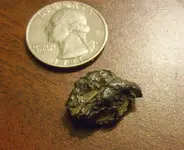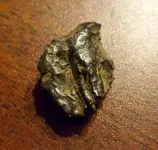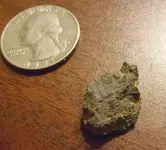Well, the surface displays the usual ablation and flow marks from atmospheric heating of the surface, edges are very rough and sharp where this section appears to have seperated from a larger body. It's very slightly magnetic, with the backside of the piece showing no sign of ablation or heating at all. The back material appears to have some very small bright/reflective points showing, but I don't have a microscope to get a really good look at them, only a fairly decent magnifying glass.
Could I be wrong? Yes, though in both the surface features and the texture of the back it is virtually identical to some other Georgia-found specimens I had the privilege to handle a couple of years ago at the Weinman museum in Cartersville a little south of here. They had a pretty fair collection at the time, and I think they've expanded it since then. I may take it down there one weekend and have it authenticated since that's the only way to really be sure.






 HH in 2010
HH in 2010 

